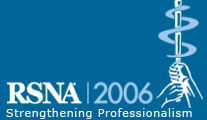
Abstract Archives of the RSNA, 2006
SSG17-04
Correction of Cross Scatter Radiation in Dual Source CT (DSCT)
Scientific Papers
Presented on November 28, 2006
Presented as part of SSG17: Physics (CT: New Systems)
Herbert Bruder PhD, Abstract Co-Author: Employee, Siemens AG
Christian Wiegand, Abstract Co-Author: Employee, Siemens AG
Karl Stierstorfer PhD, Abstract Co-Author: Employee, Siemens AG
Bernhard Krauss PhD, Abstract Co-Author: Employee, Siemens AG
Thomas G. Flohr PhD, Presenter: Employee, Siemens AG, Forchheim, Germany
To present a model based algorithm for efficient cross-scatter correction in dual source CT (DSCT) that works without direct measurement of cross-scatter radiation during scan data acquisition.
In DSCT both detectors are affected by scattered radiation at an angle of 90° which cannot be sufficiently suppressed by anti-scatter collimators. The cross-scattered radiation originates at the object surface, it is not influenced by the object's inner structure.
We developed a model-based cross-scatter correction algorithm for DSCT. We used Monte-Carlo methods to calculate cross-scatter distributions for clinically relevant objects of different size and shape. The model distributions were calibrated by measuring the amplitudes of the cross-scatter radiation for similar objects after switching off one X-ray tube of a DSCT (SOMATOM Definition, Siemens, Forchheim, Germany). During scan data acquisition, size and shape of the scanned object are determined by localizing the object edges in each projection for both measurement systems. The respective model cross-scatter distributions are then shifted in channel direction assuming scatter centers that are located at the actual object edges. The projection data are corrected with the shifted model distributions either on a linear or a logarithmic scale.
The proposed algorithm was implemented in a SOMATOM Definition DSCT scanner. We evaluated both phantom scans (elliptic and circular water phantoms of various sizes, anthropomorphic thorax phantoms) and patient scans.
Without cross-scatter correction, typical hypodense artifacts are visible both in patient scans and in phantom scans, causing deviations of the CT-values of up to 50 HU for a 30 cm water phantom. With cross-scatter correction, the artifacts are efficiently corrected both in phantom scans and in patient scans, and the deviation in a 30 cm water phantom is less than 4 HU.
We presented a model-based cross-scatter correction algorithm for DSCT that can efficiently reduce image artifacts caused by cross-scatter radiation.
Using an efficient cross-scatter correction algorithm, DSCT images meet the homogeneity standards for clinical CT images.
Bruder, H,
Wiegand, C,
Stierstorfer, K,
Krauss, B,
Flohr, T,
Correction of Cross Scatter Radiation in Dual Source CT (DSCT). Radiological Society of North America 2006 Scientific Assembly and Annual Meeting, November 26 - December 1, 2006 ,Chicago IL.
http://archive.rsna.org/2006/4434979.html

